- Sorry, this product is unavailable.
-
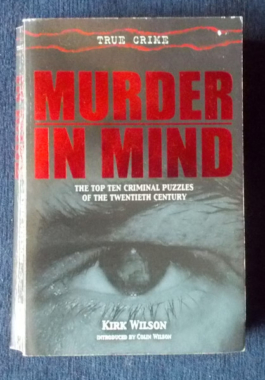 Investigative journalist Kirk Wilison tackles some of the most high-profile and confusing crimes to go unpunished. The investigations of top-ranking police officers, detectives and lawyers all failed to crack the riddles these cases created: who was responsible? And why were they never brought to justice? These are the crimes that we can never stop wondering about. Cases examined in this volume: John F. Kennedy's assassination; Jimmy Hoffa, union leader and mob associate, whose body was never found; Marilyn Monroe, screen goddess, whose 'suicide' raised more questions than it answered; Lord Lucan, peer and gambling addict, who vanished ito thin air amid accusations of murder; T. Cullen Davis, born-again Christian and the richest man ever to be tried for murder; Serge Rubenstein, the virtuoso swindler whose case was clouded by the fact that thousands of people had reason to wish him dead. Claus Von Bulow, lawyer, consultant and socialite, who made two attempts on the life of his American wife; Joan Robinson Hill may have been murdered by her husband John Hill - then it seemed that John Hill himself was murdered on his own front doorstep - but was he? Helen Vorhees Brach, who disappeared at age 65 - the victim of a slick pure-bred horse salesman?
Investigative journalist Kirk Wilison tackles some of the most high-profile and confusing crimes to go unpunished. The investigations of top-ranking police officers, detectives and lawyers all failed to crack the riddles these cases created: who was responsible? And why were they never brought to justice? These are the crimes that we can never stop wondering about. Cases examined in this volume: John F. Kennedy's assassination; Jimmy Hoffa, union leader and mob associate, whose body was never found; Marilyn Monroe, screen goddess, whose 'suicide' raised more questions than it answered; Lord Lucan, peer and gambling addict, who vanished ito thin air amid accusations of murder; T. Cullen Davis, born-again Christian and the richest man ever to be tried for murder; Serge Rubenstein, the virtuoso swindler whose case was clouded by the fact that thousands of people had reason to wish him dead. Claus Von Bulow, lawyer, consultant and socialite, who made two attempts on the life of his American wife; Joan Robinson Hill may have been murdered by her husband John Hill - then it seemed that John Hill himself was murdered on his own front doorstep - but was he? Helen Vorhees Brach, who disappeared at age 65 - the victim of a slick pure-bred horse salesman? -
 A revised, expanded collection of true crime by Australia's foremost crime writers that digs beneath the polite exterior of modern Australian life to expose its chilling core. It details the exploits of criminal families and examines the gene of pure evil that drives maniacs to randomly kill; it also explores the effect on innocent victims caught in the wrong place at the wrong time. Also included is the unstinting contribution from the cops who daily put their lives on the line and the ordinary individuals who stand up and fight back. Stories in this volume include: Donald Mackay and the Australia Mafia; the Queen Street Massacre; Ivan Milat; serial killer Paul Denyer; the Anita Cobby murder; the murder of taxi driver Peter Coe by teenagers; the Crawford murders; life as an undercover cop; and much more. Illustrated with black and white photographs.
A revised, expanded collection of true crime by Australia's foremost crime writers that digs beneath the polite exterior of modern Australian life to expose its chilling core. It details the exploits of criminal families and examines the gene of pure evil that drives maniacs to randomly kill; it also explores the effect on innocent victims caught in the wrong place at the wrong time. Also included is the unstinting contribution from the cops who daily put their lives on the line and the ordinary individuals who stand up and fight back. Stories in this volume include: Donald Mackay and the Australia Mafia; the Queen Street Massacre; Ivan Milat; serial killer Paul Denyer; the Anita Cobby murder; the murder of taxi driver Peter Coe by teenagers; the Crawford murders; life as an undercover cop; and much more. Illustrated with black and white photographs. -
 In 1982, teenager Andrew Tregurtha pleaded guilty to the murder of the Greek Consul-General and a teacher in Sydney's inner city. Six years later he committed suicide at Berrima Gaol. Between the hours of dark and daylight, the lonely hours when prisoners are locked in their cells, Andrew hanged himself. This is his own story. Tregurtha's confession confession begins with the difficulty his family experienced dealing with his undiagnosed hyperactivity and dyslexia, the ensuing confrontations with education authorities and his move to King's Cross as a fifteen year old. Here, unbeknown to his parents, he worked as a male prostitute, eventually falling under the influence of Michael Caldwell, who introduced him to the world of crime in the city. He was sixteen when he was arrested for murder. It is a harrowing tale of life on the edge, of a waif at the Cross, written simply and unglamorously, as he worked towards self-understanding and rehabilitation. Andrew too his own life before publication. Illustrated with black and white photographs.
In 1982, teenager Andrew Tregurtha pleaded guilty to the murder of the Greek Consul-General and a teacher in Sydney's inner city. Six years later he committed suicide at Berrima Gaol. Between the hours of dark and daylight, the lonely hours when prisoners are locked in their cells, Andrew hanged himself. This is his own story. Tregurtha's confession confession begins with the difficulty his family experienced dealing with his undiagnosed hyperactivity and dyslexia, the ensuing confrontations with education authorities and his move to King's Cross as a fifteen year old. Here, unbeknown to his parents, he worked as a male prostitute, eventually falling under the influence of Michael Caldwell, who introduced him to the world of crime in the city. He was sixteen when he was arrested for murder. It is a harrowing tale of life on the edge, of a waif at the Cross, written simply and unglamorously, as he worked towards self-understanding and rehabilitation. Andrew too his own life before publication. Illustrated with black and white photographs. -
 Book XII of Brother Cadfael. Christmas, A.D. 1141: Abbot Radulfus returns from London, bringing with him a priest for the vacant living of Holy Cross, also known as the Foregate. The new priest is a man of presence, learning and discipline, but he lacks humility and the common touch. When he is found drowned in the millpond, suspicion is cast upon a young man who arrived with the priest's train and was sent to work in Brother Cadfael's garden. Indeed, he is soon discovered to be an impostor. To Brother Cadfael now falls the familiar task of sorting out the complicated strands of innocence and guilt.
Book XII of Brother Cadfael. Christmas, A.D. 1141: Abbot Radulfus returns from London, bringing with him a priest for the vacant living of Holy Cross, also known as the Foregate. The new priest is a man of presence, learning and discipline, but he lacks humility and the common touch. When he is found drowned in the millpond, suspicion is cast upon a young man who arrived with the priest's train and was sent to work in Brother Cadfael's garden. Indeed, he is soon discovered to be an impostor. To Brother Cadfael now falls the familiar task of sorting out the complicated strands of innocence and guilt. -
 A young, get-ahead lawyer is approached by a group of families who believe themselves poisoned by toxic waste dumped near their water supply. Many of their children have died of leukemia. Two of America's largest companies defend the action. Nine years of tooth and nail litigation follow, with millions of dollars at stake as the lawyer fights a David and Goliath battle against the resources of big business. A true story.
A young, get-ahead lawyer is approached by a group of families who believe themselves poisoned by toxic waste dumped near their water supply. Many of their children have died of leukemia. Two of America's largest companies defend the action. Nine years of tooth and nail litigation follow, with millions of dollars at stake as the lawyer fights a David and Goliath battle against the resources of big business. A true story. -
 The author took a job in an Australian prison because - well, he needed a job, and any job would do. What had been a stop gap became and all-absorbing preoccupation with the problem of men in prison. One day, he was asked if he remembered the Greek bloke who had killed his wife with half a house brick. He couldn't remember the particular Greek - and he realised that over the seven years of his employment there, that the stone and steel had crept into his heart to the extent that a man who had killed his wife with half a house brick had left no impression on him. In search of what beliefs and values he had left to him after prolonged exposure to the brutality, cynicism and despair of a big maximum-security prison, the author examines his experiences, not as a psychologist, but as a man whose profession is psychology. In the process, comes to several important conclusions.
The author took a job in an Australian prison because - well, he needed a job, and any job would do. What had been a stop gap became and all-absorbing preoccupation with the problem of men in prison. One day, he was asked if he remembered the Greek bloke who had killed his wife with half a house brick. He couldn't remember the particular Greek - and he realised that over the seven years of his employment there, that the stone and steel had crept into his heart to the extent that a man who had killed his wife with half a house brick had left no impression on him. In search of what beliefs and values he had left to him after prolonged exposure to the brutality, cynicism and despair of a big maximum-security prison, the author examines his experiences, not as a psychologist, but as a man whose profession is psychology. In the process, comes to several important conclusions. -
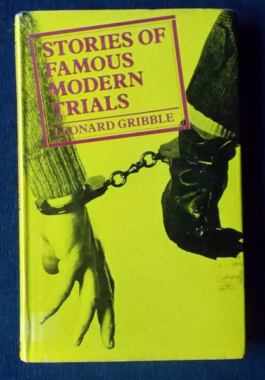 With such intriguing chapters as: The Riddle of the Bordereau (the Dreyfus case); Murder in High Society (the murder of Stanford White and the affair of Evelyn Stanford nee Nesbit and Harry Thaw) ; the Tragedy of Oscar Slater (the murder of Marion Gilchrist); The Original Winslow Boy (the tragedy caused by the theft of a five shilling postal order); A Matter of High Treason (Roger Casement); The Green Bicycle Mystery (the murder of Bella Wright) ; Buccaneer in Morning Coat (Horatio Bottomley, swindler par excellence) ; The Incredible Fire Raisers (the Leopold Harris arson gang) ; Justice Comes To Nuremburg; The Double Betrayal (the case of Klaus Fuchs); Teenagers On A Roof (the thrill-killing of a police man in London, 1952) ; The Great Train Robbers.
With such intriguing chapters as: The Riddle of the Bordereau (the Dreyfus case); Murder in High Society (the murder of Stanford White and the affair of Evelyn Stanford nee Nesbit and Harry Thaw) ; the Tragedy of Oscar Slater (the murder of Marion Gilchrist); The Original Winslow Boy (the tragedy caused by the theft of a five shilling postal order); A Matter of High Treason (Roger Casement); The Green Bicycle Mystery (the murder of Bella Wright) ; Buccaneer in Morning Coat (Horatio Bottomley, swindler par excellence) ; The Incredible Fire Raisers (the Leopold Harris arson gang) ; Justice Comes To Nuremburg; The Double Betrayal (the case of Klaus Fuchs); Teenagers On A Roof (the thrill-killing of a police man in London, 1952) ; The Great Train Robbers. -
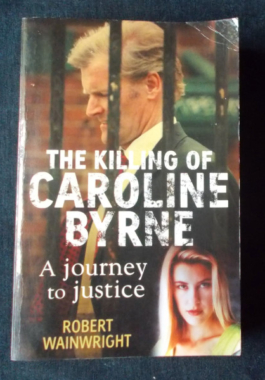 On a bleak, moonless winter night in 1995 beautiful Sydney model Caroline Byrne died, her body embedded head-first into a crevice at the bottom of The Gap at the entrance to Sydney Harbor. How did she get out so far, almost 12 meters from the base of the sheer sandstone precipice? Did she jump, as so many had done before at the notorious suicide spot, or had she been thrown in a fit of rage? What began as a sad ritual of retrieving the shattered bodies of shattered lives turned into one of the nation's most extraordinary murder investigations, leading to the dark heart of a city gripped by greed, pandering to its powerful and exposing a police force whose lack of imagination and resources was surpassed only by the doggedness of its finest officers to right an unforgivable wrong. this is a journey to justice: the astonishing inside story of Caroline's father Tony Byrne's determination to find the truth of his daughter's death and in doing so, test the justice system to its limits.
On a bleak, moonless winter night in 1995 beautiful Sydney model Caroline Byrne died, her body embedded head-first into a crevice at the bottom of The Gap at the entrance to Sydney Harbor. How did she get out so far, almost 12 meters from the base of the sheer sandstone precipice? Did she jump, as so many had done before at the notorious suicide spot, or had she been thrown in a fit of rage? What began as a sad ritual of retrieving the shattered bodies of shattered lives turned into one of the nation's most extraordinary murder investigations, leading to the dark heart of a city gripped by greed, pandering to its powerful and exposing a police force whose lack of imagination and resources was surpassed only by the doggedness of its finest officers to right an unforgivable wrong. this is a journey to justice: the astonishing inside story of Caroline's father Tony Byrne's determination to find the truth of his daughter's death and in doing so, test the justice system to its limits. -
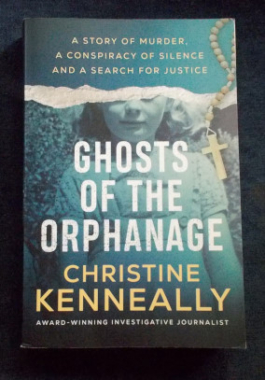 This is the shocking secret history of twentieth-century orphanages - which for decades hid violence, abuse, and deaths within their walls. For much of the twentieth century, a series of terrible events - abuse, both physical and psychological, and even deaths - took places inside orphanages. The survivors have been trying to tell their astonishing stories for a long time, but disbelief, secrecy, and trauma have kept them from breaking through. For ten years, Christine Kenneally has been on a quest to uncover the harrowing truth. Centering her story on St. Joseph’s, a Catholic orphanage in Vermont, Kenneally has written a stunning account of a series of crimes and abuses. But her work is not confined to one place. Following clues that take her into the darkened corners of several institutions across the globe, she finds a trail of terrifying stories and a courageous group of survivors who are seeking justice. Ghosts of the Orphanage is an incredible true crime story and a reckoning with a past that has stayed buried for too long, with tragic consequences.
This is the shocking secret history of twentieth-century orphanages - which for decades hid violence, abuse, and deaths within their walls. For much of the twentieth century, a series of terrible events - abuse, both physical and psychological, and even deaths - took places inside orphanages. The survivors have been trying to tell their astonishing stories for a long time, but disbelief, secrecy, and trauma have kept them from breaking through. For ten years, Christine Kenneally has been on a quest to uncover the harrowing truth. Centering her story on St. Joseph’s, a Catholic orphanage in Vermont, Kenneally has written a stunning account of a series of crimes and abuses. But her work is not confined to one place. Following clues that take her into the darkened corners of several institutions across the globe, she finds a trail of terrifying stories and a courageous group of survivors who are seeking justice. Ghosts of the Orphanage is an incredible true crime story and a reckoning with a past that has stayed buried for too long, with tragic consequences. -
 On Christmas Eve 2002, Laci Peterson, a young wife and mother-to-be, disappeared from her home in Modesto, California...Praying for a happy ending, friends and family stood by Laci's grieving husband Scott. Four months later, Laci's decomposed body was found in the murky waters of San Francisco Bay. The body of her child had washed ashore about a mile away, after a possible "coffin birth". It was a sad closure to an exhaustive search, and a grim end to a marriage that by all account had appeared to be perfect. But the authorities already had a prime suspect...Scott Peterson's behavior had cast a mysterious shadow over the death of his pregnant wife - his alibi on the day of the disappearance was questionable; he admitted to an affair with another woman; and when he was finally charged with capital murder, he had altered his appearance. But it was only after a stunning criminal trial - packed with even more shocking revelations - that a jury convicted Scott Peterson of murder and sentenced him to death. With black and white photographs.
On Christmas Eve 2002, Laci Peterson, a young wife and mother-to-be, disappeared from her home in Modesto, California...Praying for a happy ending, friends and family stood by Laci's grieving husband Scott. Four months later, Laci's decomposed body was found in the murky waters of San Francisco Bay. The body of her child had washed ashore about a mile away, after a possible "coffin birth". It was a sad closure to an exhaustive search, and a grim end to a marriage that by all account had appeared to be perfect. But the authorities already had a prime suspect...Scott Peterson's behavior had cast a mysterious shadow over the death of his pregnant wife - his alibi on the day of the disappearance was questionable; he admitted to an affair with another woman; and when he was finally charged with capital murder, he had altered his appearance. But it was only after a stunning criminal trial - packed with even more shocking revelations - that a jury convicted Scott Peterson of murder and sentenced him to death. With black and white photographs. -
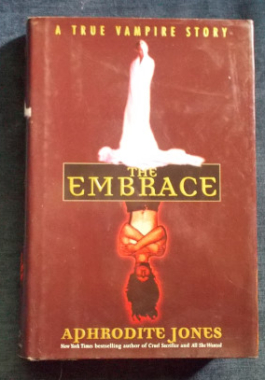
The Embrace: Aphrodite Jones
$20.00On November 25, 1996, in their home in the lakeside community of Eustis, Florida, Rick and Ruth Wendorf were savagely beaten to death with a tire iron. The Wendorfs' new Ford Explorer was stolen, but this was no routine robbery gone bad. This was a crime carried out by one Roderick Ferrell, a sixteen-year-old self-avowed Antichrist. His human sacrifice was a testament to the unique and sinister bond of four brainwashed teens. Heather Wendorf was a straight "A" student, a petite blonde with wide-set brown eyes. Yet she had been heard to wish her parents "off the face of the planet." Heather never dreamed that when she joined her friends for a joyride one fall evening, her wish had already come true. Including exclusive interviews with every living character involved in the case. -
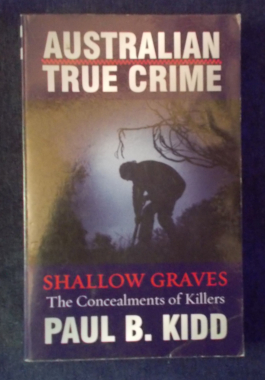 Shallow graves play a grim part in many of Australia's most mysterious, bizarre and horrendous murder cases. And Australia's bushland, beaches, deserts, foreshores and suburban landscapes offer many opportunities for a murderer to hide his victim. But in this updated edition, Kidd points out how even the best-laid plans of the most devious can go astray when a body turns up. Illustrated with black and white photographs.
Shallow graves play a grim part in many of Australia's most mysterious, bizarre and horrendous murder cases. And Australia's bushland, beaches, deserts, foreshores and suburban landscapes offer many opportunities for a murderer to hide his victim. But in this updated edition, Kidd points out how even the best-laid plans of the most devious can go astray when a body turns up. Illustrated with black and white photographs. -
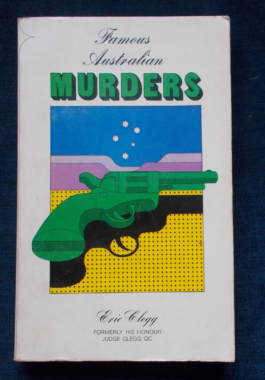 Eric Clegg, formerly His Honour Eric Clegg Q.C. is more than qualified to examine these famous trials and his expert viewpoint reveals many important and often controversial points which arose during the hearings. Cases contained in this volume include: The Kalgoorlie murders of two policemen in 1926, found down a disused mine-shaft; the Passionate Parson, acquitted on a charge of murdering his wife; the Lavers mstyery and the Sundown murders; the Pyjama Girl murder; the fantastic case of T. J. Ley, former Minister for Justice in New South Wales who was eventually convicted for the chalkpit murders and more. Illustrated with black and white photographs.
Eric Clegg, formerly His Honour Eric Clegg Q.C. is more than qualified to examine these famous trials and his expert viewpoint reveals many important and often controversial points which arose during the hearings. Cases contained in this volume include: The Kalgoorlie murders of two policemen in 1926, found down a disused mine-shaft; the Passionate Parson, acquitted on a charge of murdering his wife; the Lavers mstyery and the Sundown murders; the Pyjama Girl murder; the fantastic case of T. J. Ley, former Minister for Justice in New South Wales who was eventually convicted for the chalkpit murders and more. Illustrated with black and white photographs. -
 On December 10, 2003 an intruder waits inside the home of Kent and Tricia Whitaker. They and their two sons, Bart and Kevin, are returning from a dinner celebrating Bart's college graduation. Four shots ring out: Tricia and Kevin are killed instantly, Kent is wounded and Bart. struggling with the gunman, is also wounded. Three days later, as investigators explore leads in the search for justice for the victims, they find Bart had been leading a double life and he becomes the chief suspect. Kent believes the police are allowing the real killer to escape while they focus on Bart but when Bart disappears in the mountains of Mexico seven months later, Kent must face the possibility his son was involved in the murder. Fifteen months later, Bart is arrested and charged with masterminding the shootings; in March 2007, he is convicted and sentenced to death. How can a father survive the anguish of his son's actions and forgive such betrayal?
On December 10, 2003 an intruder waits inside the home of Kent and Tricia Whitaker. They and their two sons, Bart and Kevin, are returning from a dinner celebrating Bart's college graduation. Four shots ring out: Tricia and Kevin are killed instantly, Kent is wounded and Bart. struggling with the gunman, is also wounded. Three days later, as investigators explore leads in the search for justice for the victims, they find Bart had been leading a double life and he becomes the chief suspect. Kent believes the police are allowing the real killer to escape while they focus on Bart but when Bart disappears in the mountains of Mexico seven months later, Kent must face the possibility his son was involved in the murder. Fifteen months later, Bart is arrested and charged with masterminding the shootings; in March 2007, he is convicted and sentenced to death. How can a father survive the anguish of his son's actions and forgive such betrayal? -
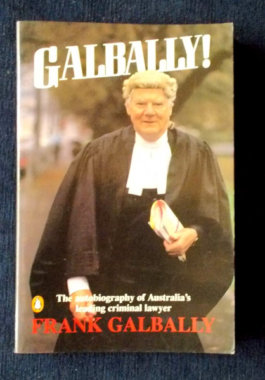
Galbally! Frank Galbally
$9.00Frank Galbally CBE (1922 - 2005) dominated Australian Law for over four decades, frequently at the centre of controversy and always at the heart of things. He represented everyone from painters and dockers to a talking cockatoo; had audiences with popes and took on the Greek Colonels and was embroiled in the politics of 1975 and the policies of Collingwood Football Club. The Krope trial, the Costigan Commission, Kevin Barlow's appeal...the number of legal trials in which Galbally was involved extraordinary and the names became household words. This autobiography contains some of his most famous cases, with a few fighting words regarding crucial aspects of Australian public affairs such as police corruption and the royal commission into crime. Illustrated with black and white photographs. -
 Two wives, two violent murders and a fight for justice...the story of one of the more bizarre murder investigations in Australia’s history. Two wives die in suspicious co-incidence or, as husband Thomas Keir describes it, ‘bad luck’? Three years after Thomas Keir alleged his first wife Jean deserted him and her young son for another man, his second wife Rosalina, Jean’s cousin, lay scorched and strangled on her bed. Arriving on the scene, Detective Peter Seymour realised he was dealing with the world’s unluckiest husband or a serial wife killer.While Keir was remarkably found ‘not guilty’ of Rosalina’s murder - despite a clear cut case - her death unlocked the mystery of Jean’s disappearance. A subsequent police investigation lead to the discovery of seven small fragments of Jean’s bones - fingers, knuckles and toes - buried deep under the same house in which Rosalina died. Keir’s ‘grieving husband’ act was suddenly in question. The investigation revealed Thomas Keir was a man so jealous he hated even his own baby son touching his wife, Jean. A man so possessive he threatened he would cut her up and feed her to the dogs if she ever left him. A man who thought he could commit the perfect crime and publicly taunted the police through the media. This is Detective Peter Seymour's relentless pursuit of justice and his own family sacrifices, through the drama of the police investigation into Jean’s death, and the three trials, convictions, and appeals that would take fifteen years to reach their final conclusion. Photograph illustrations.
Two wives, two violent murders and a fight for justice...the story of one of the more bizarre murder investigations in Australia’s history. Two wives die in suspicious co-incidence or, as husband Thomas Keir describes it, ‘bad luck’? Three years after Thomas Keir alleged his first wife Jean deserted him and her young son for another man, his second wife Rosalina, Jean’s cousin, lay scorched and strangled on her bed. Arriving on the scene, Detective Peter Seymour realised he was dealing with the world’s unluckiest husband or a serial wife killer.While Keir was remarkably found ‘not guilty’ of Rosalina’s murder - despite a clear cut case - her death unlocked the mystery of Jean’s disappearance. A subsequent police investigation lead to the discovery of seven small fragments of Jean’s bones - fingers, knuckles and toes - buried deep under the same house in which Rosalina died. Keir’s ‘grieving husband’ act was suddenly in question. The investigation revealed Thomas Keir was a man so jealous he hated even his own baby son touching his wife, Jean. A man so possessive he threatened he would cut her up and feed her to the dogs if she ever left him. A man who thought he could commit the perfect crime and publicly taunted the police through the media. This is Detective Peter Seymour's relentless pursuit of justice and his own family sacrifices, through the drama of the police investigation into Jean’s death, and the three trials, convictions, and appeals that would take fifteen years to reach their final conclusion. Photograph illustrations. -
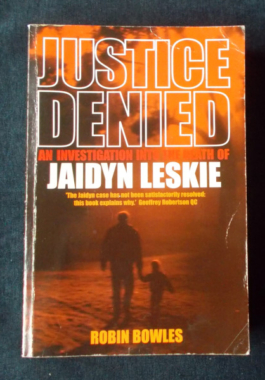 This is the book the Victorian police did not want written. On 14 June 1997, a toddler is left alone in the middle of the night while the babysitter collects his mother from a party. In their absence, the windows are smashed and a severed pig's head is thrown into the room where the child was left sleeping. On their return, the pig's head is is waiting and the child has vanished. Within twenty-four hours the Homicide Squad rules out any involvement of the 'pig's head team' (the vandals who left the pig's head and smashed the windows, determined by police to be an unrelated act of revenge against Domaszewicz) or anyone else in the baby's disappearance and settles on the babysitter as the prime suspect. The child was Jaidyn Leskie. The suspect, Greg Domaszewicz, was arrested, charged and eventually acquitted of murdering Jaidyn. Case closed - or is it? Featuring exclusive interviews and evidence made public for the first time, this is a tightly woven building of this unsolved mystery that builds to a conclusion that could leave the reader sleepless...Illustrated with black and white photos.
This is the book the Victorian police did not want written. On 14 June 1997, a toddler is left alone in the middle of the night while the babysitter collects his mother from a party. In their absence, the windows are smashed and a severed pig's head is thrown into the room where the child was left sleeping. On their return, the pig's head is is waiting and the child has vanished. Within twenty-four hours the Homicide Squad rules out any involvement of the 'pig's head team' (the vandals who left the pig's head and smashed the windows, determined by police to be an unrelated act of revenge against Domaszewicz) or anyone else in the baby's disappearance and settles on the babysitter as the prime suspect. The child was Jaidyn Leskie. The suspect, Greg Domaszewicz, was arrested, charged and eventually acquitted of murdering Jaidyn. Case closed - or is it? Featuring exclusive interviews and evidence made public for the first time, this is a tightly woven building of this unsolved mystery that builds to a conclusion that could leave the reader sleepless...Illustrated with black and white photos. -
 The case of Dr. Crippen has passed into folklore as one of the most infamous in criminal history. The year: 1910. The details: a hideously mutilated body in the cola cellar, a dockside arrest in Canada - by the means of the new wireless telegraph - of Crippen and his mistress, disguised as a boy, the trial with legal luminaries and society notables. There was enough sensation to place Crippen in the top ranks of master criminals. Yet Crippen was a quiet, meek little man, a hen-pecked husband who was always gentle with his shrewish wife, a business failure passionately in love with his competent young secretary, a bungler whose one venture into murder went wrong at every step of the way. This study examines the character of the man many believed incapable of murder and reveals the story of a mismatched marriage and a love affair that - out of its context - would have been an inspiration. Illustrated with black and white photographs. Appendix reproduces Crippen's letters to Ethel LeNeve, written from Pentonville Prison.
The case of Dr. Crippen has passed into folklore as one of the most infamous in criminal history. The year: 1910. The details: a hideously mutilated body in the cola cellar, a dockside arrest in Canada - by the means of the new wireless telegraph - of Crippen and his mistress, disguised as a boy, the trial with legal luminaries and society notables. There was enough sensation to place Crippen in the top ranks of master criminals. Yet Crippen was a quiet, meek little man, a hen-pecked husband who was always gentle with his shrewish wife, a business failure passionately in love with his competent young secretary, a bungler whose one venture into murder went wrong at every step of the way. This study examines the character of the man many believed incapable of murder and reveals the story of a mismatched marriage and a love affair that - out of its context - would have been an inspiration. Illustrated with black and white photographs. Appendix reproduces Crippen's letters to Ethel LeNeve, written from Pentonville Prison.


